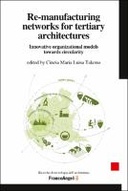Explore

Re-manufacturing networks for tertiary architectures
0 Ungluers have
Faved this Work
Login to Fave
This book deals with re-manufacturing, recondition, reuse and repurpose considered as winning strategies for boosting regenerative circular economy in the building sector. It presents many of the outcomes of the research Re-NetTA (Re-manufacturing Networks for Tertiary Architectures).
New organisational models and tools for re-manufacturing and re-using short life components coming from tertiary buildings renewal, funded in Italy by Fondazione Cariplo for the period 2019-2021.
The field of interest of the book is the building sector, focusing on various categories of tertiary buildings, characterized by short term cycles of use.
The book investigates the most promising strategies and organizational models to maintain over time the value of the environmental and economic resources integrated into manufactured products, once they have been removed from buildings, by extending their useful life and their usability with the lower possible consumption of other materials and energy and with the maximum containment of emissions into the environment. The text is articulated into three sections.
Part I BACKGROUND introduces the current theoretical background and identifies key strategies about circular economy and re-manufacturing processes within the building sector, focusing on tertiary architectures. It is divided into three chapters.
Part II PROMISING MODELS outlines, according to a proposed framework, a set of promising circular organizational models to facilitate re-manufacturing practices and their application to the different categories of the tertiary sectors: exhibition, office and retail. This part also reports the results of active dialogues and roundtables with several categories of operators, adopting a stakeholder perspective.
Part III INSIGHTS provides some insights on the issue of re-manufacturing, analyzed from different perspectives with the aim of outlining a comprehensive overview of challenges and opportunities for the application of virtuous circular processes within building sector. Part III is organized in four key topics: A) Design for Re-manufacturing; B) Digital Transformation; C) Environmental Sustainability; D) Stakeholder Management, Regulations & Policies.
This book is included in DOAB.
Why read this book? Have your say.
You must be logged in to comment.
Rights Information
Are you the author or publisher of this work? If so, you can claim it as yours by registering as an Unglue.it rights holder.Downloads
This work has been downloaded 45 times via unglue.it ebook links.
- 45 - pdf (CC BY-NC-ND) at OAPEN Library.
Keywords
- Architectural structure & design
- Architecture
- Circular Economy
- Construction sector
- Design for Disassembly
- Environmentally-friendly architecture & design
- extending life cycle
- Product-Service Systems
- reuse and remanufacturing
- The arts
- thema EDItEUR::A The Arts::AM Architecture::AMC Architectural structure and design::AMCR Environmentally-friendly (‘green’) architecture and design
- thema EDItEUR::A The Arts::AM Architecture::AMG Architecture: public, commercial and industrial buildings
Editions

